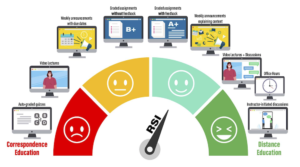
OSCQR – Standard #9
Course objectives/outcomes are clearly defined, measurable, and aligned to learning activities and assessments.
Review These Explanations
Learning objectives and outcomes are essentially milestones on the learning pathway – milestones that learners need to achieve in order to succeed. Course objectives should express some level of mastery that learners will need to demonstrate as a result of participating fully in the course. Learners need to understand how what they are learning, and what they are required to demonstrate, are connect to the course outcomes.
All course content, learning activities, interactions and assessments should be in alignment with these objectives/outcomes. These relationships should be clearly explained in order to provide relevance of learning to the learners (Knowles, 1984). Objectives should address what learners need to know when they complete the module, course, or program, and aligned activities and assessments should showcase how learners have achieved those objectives.
Keep in mind that well written learning objectives are made up of four parts – the identity of the learner, the skill that you want the learner to demonstrate, the conditions under the learner will demonstrate that skill, and the criteria in place to measure mastery of that skill.
Overall course objectives should be clearly communicated via the syllabus and course information documents, and module objectives should be introduced at the beginning of every module.
References:
Knowles, M. (1984). Andragogy in Action. San Francisco: Jossey-Bass.
Regular and Substantive Interaction (RSI)
How This Standard Supports RSI
Online course objectives detail the course goals and expected learning outcomes for learners in the online course. This standard can support regular and substantive interaction by providing learners with opportunities to establish and discuss the relevance of the studied materials to their academic, professional, and personal lives. Giving learners the opportunity to interact with the instructor to discuss their reasons for taking the course, prior knowledge of course discipline/content, and expectations for the course are all good strategies that can be accomplished in the design and activities of the course. For example in an ice breaking discussion. Directing learners to ask questions and interact with the instructor about these topics as the course begins, such as in an online discussion forum, further supports RSI, and is a good general practice. Scheduling a specific instructor-facilitated introductory discussion demonstrates compliance with RSI.
Refresh Your Course with These Ideas
General Suggestions
- Map all content, interaction, activity, and assessment to module, course, and program objectives. This exercise will show you if your objectives are aligned, and if one or more course elements needs to be adapted to better meet the set objectives. This can be done with a simple table where each activity and assignment are listed (rows), and a check mark indicates associated objectives (columns).
- Avoid “busy work” or assignments not clearly aligned with stated outcomes.
- Explore Bloom’s Taxonomy and associate resources to better understand types of objectives and related examples of ways to measure success through activities and assessments.
Examples
- Use verbs that are actionable and measurable in writing objectives/outcomes. Test each objective/outcome by detailing out exactly how you are measuring it, and how you will know learners have met set criteria.
- Verbs should be measurable in describing outcomes. “Learners will understand” is not measurable. How will learners demonstrate, or make their “understanding” visible? Preferred: “You will research and write a five page research paper to demonstrate your understanding of x” is a measurable activity.
- How NOT to Write Objectives.
- Bloom Taxonomy with Verbs.
- Action Verbs for Learning Objectives.
- ASU Learning Objectives Builder.
- Create a course or module map to share with your learners that details how each objective falls in sequence in the course, along with the activities and assignments that measure associated knowledge and/or mastery.
- Use the 2nd person (you/your) tense in communicating the objectives, instead of a generic “learners will learn”. This personalizes the statement for your learners.
- Reiterate the association and alignment of learning objectives by listing any associated objectives in the activity or assignment instructions.
Explore More Refreshing Ideas from the Teaching Online Pedagogical Repository (TOPR) at the University of Central Florida (UCF)
This Pedagogical Practice from TOPR explores the purpose and benefits of breaking down course objectives to the modular level, and provides an example of scaffolding learning across modules.
Explore Related Resources
Share What You Know
OSCQR has been developed by a community of online practitioners interested in quality course design. There are numerous opportunities for community members to offer suggestions, donate resources, and help with future development.
Discuss this standard in the comments section at the bottom of this page.
Contribute your own ideas or refresh resources by filling out the OSCQR Examples Contribution Form.